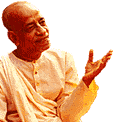Chapter 8: Attaining the Supreme
Bg 8.14
TEXT 14
ananya-cetah satatam
yo mam smarati nityasah
tasyaham sulabhah partha
nitya-yuktasya yoginah
yo mam smarati nityasah
tasyaham sulabhah partha
nitya-yuktasya yoginah
SYNONYMS
ananya-cetah—without deviation; satatam—always; yah—anyone; mam—Me (Krsna); smarati—remembers; nityasah—regularly; tasya—to him; aham—I am; sulabhah—very easy to achieve; partha—O son of Prtha; nitya—regularly; yuktasya—engaged; yoginah—of the devotee.
TRANSLATION
For one who remembers Me without deviation, I am easy to obtain, O son of Prtha, because of his constant engagement in devotional service.
PURPORT
In this verse the bhakti-yoga of the unalloyed devotees of the Supreme Godhead is described. The preceeding verses mention four different kinds of devotees—the distressed, the inquisitive, those who seek material gain, and the speculative philosophers. Different processes of liberation from material entanglement have also been described: karma-yoga, jnana-yoga, and hatha-yoga. But here bhakti-yoga, without any mixture of these, is mentioned. In bhakti-yoga the devotees desire nothing but Krsna. The pure bhakti devotee does not desire promotion to heavenly planets, nor does he seek salvation or liberation from material entanglement. A pure devotee does not desire anything. In the Caitanya-caritamrta the pure devotee is called niskama, which means he has no desire for self-interest. Perfect peace belongs to him alone, not to them who strive for personal gain. The pure devotee only wants to please the Supreme Lord, and so the Lord says that for anyone who is unflinchingly devoted to Him, He is easy to attain. The devotee can render service to any of the transcendental forms of the Supreme Lord, and he meets with none of the problems that plague the practitioners of other yogas. Bhakti-yoga is very simple and pure and easy to perform. One can begin by simply chanting Hare Krsna. Krsna is very merciful to those who engage in His service, and He helps in various ways that devotee who is fully surrendered to Him so he can understand Him as He is. The Lord gives such a devotee sufficient intelligence so that ultimately the devotee can attain Him in His spiritual kingdom.
The special qualification of the pure devotee is that he is always thinking of Krsna without considering the time or place. There should be no impediments. He should be able to carry out his service anywhere and at any time. Some say that the devotee should remain in holy places like Vrndavana or some holy town where the Lord lived, but a pure devotee can live anywhere and create the atmosphere of Vrndavana by his devotional service. It was Sri Advaita who told Lord Caitanya, "Wherever You are, O Lord—there is Vrndavana."
A pure devotee constantly remembers Krsna and meditates upon Him. These are qualifications of the pure devotee for whom the Lord is most easily attainable. Bhakti-yoga is the system that the Gita recommends above all others. Generally, the bhakti-yogis are engaged in five different ways: 1) santa-bhakta, engaged in devotional service in neutrality; 2) dasya-bhakta, engaged in devotional service as servant; 3) sakhya-bhakta, engaged as friend; 4) vatsalya-bhakta, engaged as parent; and 5) madhurya-bhakta, engaged as conjugal lover of the Supreme Lord. In any of these ways, the pure devotee is always constantly engaged in the transcendental loving service of the Supreme Lord and cannot forget the Supreme Lord, and so for him the Lord is easily attained. A pure devotee cannot forget the Supreme Lord for a moment, and similarly, the Supreme Lord cannot forget His pure devotee for a moment. This is the great blessing of the Krsna conscious process of chanting the mahamantra, Hare Krsna.
Copyright (c) 1972 by His Divine Grace A.C. Bhaktivedanta Swami Prabhupada











